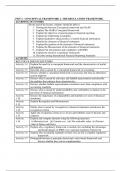Other
Study Guide for Financial Reporting Exams
- Course
- Institution
In this study guide, you will be guided in revising for your financial reporting exams, whether it's for your CPA exams, ACCA exams, CIMA exams, other school or college Financial Reporting exams. You will learn standards relating to Property, Plant and Equipment, Borrowing Cost, Intangible Asset...
[Show more]



